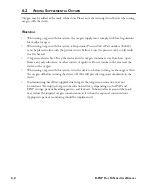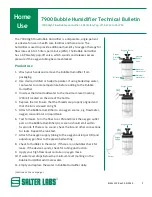
4-2
B
I
pap p
lus
m s
erIes
u
ser
m
anual
3.
Press the
button to turn on the airflow. The Active Display screen appears,
shown in Figure 4–3.
9.0
cmH2O
E
20.0
cmH2O
I
Active Screen During Exhalation (EPAP)
Active Screen During Inhalation (IPAP)
f
Igure
4–3 a
CtIve
d
Isplay
The Active Display screen shows the set pressure.
Some symbols indicating when certain conditions are turned on or detected will also appear
on the Active Display screen or on the Standby screen. These symbols are described below:
s
ymBol
d
esCrIptIon
Ramp – You can initiate the ramp feature by pressing the Ramp button. The ramp
symbol displays on the Active Display screen when the ramp function is active.
E
EPAP – Expiratory Positive Airway Pressure
I
IPAP – Inspiratory Positive Airway Pressure
Mask
Alert
Mask Leak Alert – This flashing text displays on the Active Display screen if the
Mask Alert setting is enabled and the device detects an excessive mask leak.
Auto
Off
Auto-Off – This flashing text displays on the Standby screen if the Auto-Off
setting is enabled and the device detects a mask disconnect.
4. Put on your mask assembly when the air starts to flow.
5. Make sure that no air is leaking from your mask into your eyes. If it is, adjust the mask and
headgear until the air leak stops. See the instructions provided with your mask for more
information.
Note:
A small amount of mask leak is normal and acceptable. Correct large mask
leaks or eye irritation from an air leak as soon as possible.
6. If you are using the device while sleeping, try placing the tubing from the device over your
headboard. This may reduce tension on the mask.
Note:
If you are having trouble with your mask, refer to the instructions included with
the mask.
















































